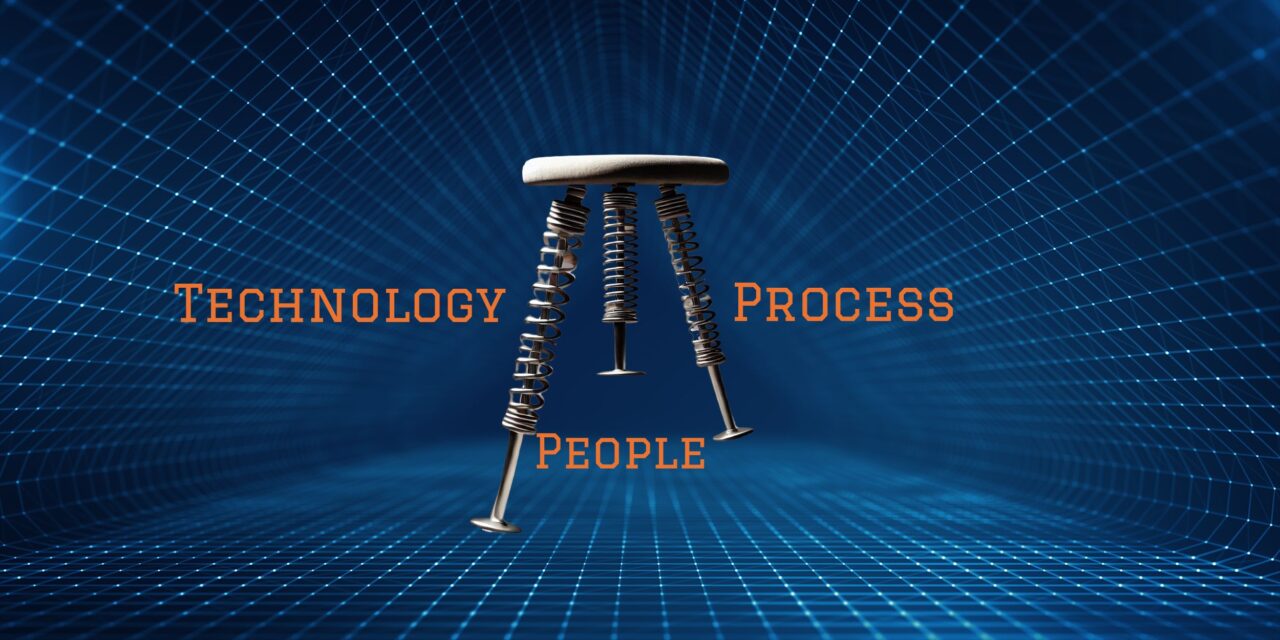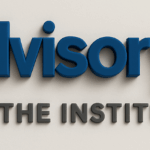The Golden Triangle, otherwise known as the PPT (People, Process, and Technology) framework, was introduced by Harold Leavitt in the 1960’s.[i] The main concept of the PPT framework is that in any business initiative – such as digital transformation – the key to success is finding the balance between each of the three elements. A three-legged stool is a metaphor often used to describe the need for balance within PPT. If any of the legs is not the same size as the others, the stool will fall over – in other words, the business initiative will likely fail.
I recently watched this episode of Digital Dialogue produced by the Institute for Digital Transformation on the topic of PPT. During the discussion, one of the panelists, David Mainville, said, “[for many organizations, PPT] is not a [three legged] stool; it’s three pogo sticks. Someone is bouncing on the ‘people’ pogo stick; someone is bouncing on the ‘process’ pogo stick; and someone is bouncing on the ‘technology’ pogo stick. And they’re not talking to each other! […]This is a reason many projects fail.”
Sadly, I had to agree with David. I’ve seen this many times. A lot of energy and effort is directed into each of these foundational elements for success. But that energy and work is often disjointed and uneven. Making it even worse is that of the three elements, it’s usually the technology leg where most of the effort and investments are made…and the people element is the most ignored.
How do organizations build a PPT stool with Pogo Sticks?
There are many reasons why organizations have built their PPT foundation on pogo sticks.
The first reason is what I would call the “allure of technology”. Executives and key business stakeholders are continually bombarded with the latest and greatest tools and technologies, all seemingly designed to solve every business problem. The implementation of that technology is made to appear simple; purchasing that technology is even easier.
But then the problems begin. While it is relatively ‘easy to write a check’ to purchase technology, in many cases, the purchased technology is a solution looking for a problem to solve. There is too much focus on finding that technology “silver bullet” that solves a (real or imagined) business problem. The connection between the technology solution and business strategy has not been defined. And because the organization has made the investment in this new technology, the new technology is ‘jammed in’ to the existing technology environment, with little to no effort regarding integration with existing technology, much less process redesign or training employees on how to use the new technology.
The second reason organizations wind up with a PPT foundation of pogo sticks is a lack of formal approach to continual improvement. Process design is treated as a one-and-done activity and is not revisited as business and regulatory conditions evolve. There is little to no standardization of process across the organization, and no effort is invested to identify and remove bottlenecks and other waste in process flow. Performance issues with technology are not addressed from a holistic perspective, resulting in an ongoing accumulation of technical debt. This in turn, results in people working harder to produce diminishing returns.
Lastly, and most importantly, there is inadequate investment into on-going training, communication, and upskilling of the organization’s most valuable resource – its people. People are the bedrock of an organization – it’s people that use the technology; it’s people that utilize processes. But dealing with people can get messy sometimes. People are often viewed as a costly expense rather than as a valuable and differentiated asset. How many times have you heard or read that a justification for a technology investment is to reduce the expenses associated with headcount (people)?
PPT must start with People
But balance is required for success
Despite the ever-changing and rapid pace of new and innovative technology solutions within the marketplace, the need for balance with PPT continues to be key for success – whether that is with digital transformation or any other business initiative. And success with PPT must start with people.
People are the most dynamic, innovative, creative, and critical element of the PPT framework. Without the strong contribution of people, neither process nor technology provides little, if any value or impact on an organization.
Process is the PPT element that connects people and technology. Process ensures that the organization realizes business value and results, both from the efforts of people within the organization and from investments in technology. Process ensures that the individual efforts of people within the organization are aligned in direction and results and provides the means for measuring the work being done.
The ironic thing about the technology element of PPT is that this should be the leg of the stool that should be the easiest to implement – if the people and process elements have been properly addressed. Unfortunately, most investment and efforts of business initiatives focus here, frequently leaving organizations with a technological capability that neither people nor processes can fully utilize. Technology overfocus is often a causal factor in the formation of data siloes (the technology used to manage certain data becomes the barrier to sharing that data), which in turn become organizational siloes because process designs are not updated to ensure the flow of work and information. This results in a significant organizational constraint when it comes to making business decisions and responding to changes in market conditions. To top it off in the irony of all ironies, technology becomes the scapegoat when anticipated benefits are not realized.
Get off the Pogo Sticks!
How can organizations get off the pogo sticks and onto a solid and business-enabling PPT foundation? Here are four suggestions.
- Value stream mapping – Understanding how value moves through an organization – and the contribution of people in enabling value realization – is a learning enabled by value stream mapping. A value stream map also depicts how process and technology contribute to that value realization.
- Journey mapping – A journey map depicts the user’s perspective when that user interacts with an organization to accomplish a goal. Journey maps help identify areas of friction, dissatisfaction, critical moments of truth, and opportunities for improvement and innovation.
- Start and nurture a formal continual improvement practice. Continual improvement must become a core competency of any digital age organization. The name of the game for the digital business is constant digital evolution – and a formalized continual improvement practice enables the digital organization to keep pace with this evolution, as well as eliminate the technical debt that is a drag on the business.
- Adopt a “people first” strategy with any business initiative – By taking a “people first” approach to business initiatives allows the organization to best utilize this most valuable asset – its people. Understanding the strengths, weaknesses, competencies, and concerns of people is critical for designing the appropriate approach to organizational change management and the ultimate success of a business initiative.
The golden triangle of the PPT framework – starting with people – is a time-tested and proven approach to success with any business initiative. But if your organization finds its PPT stool standing on pogo sticks, the suggestions above will help provide a strong foundation for success.
[i] https://www.forbes.com/sites/forbestechcouncil/2021/02/11/how-understanding-the-golden-triangle-drives-procurement-and-digital-transformation, Retrieved April, 2024.
Tag/s:Business TransformationDigital EnterpriseEmployee ExperienceOrganizational Change





